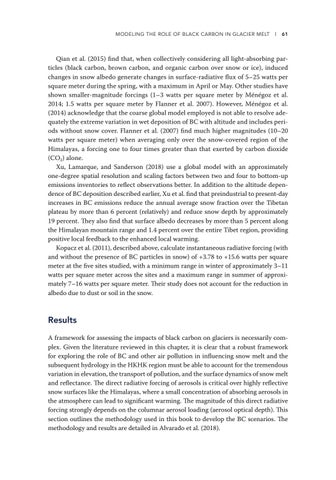Modeling the Role of Black Carbon in Glacier Melt l 61
Qian et al. (2015) find that, when collectively considering all light-absorbing particles (black carbon, brown carbon, and organic carbon over snow or ice), induced changes in snow albedo generate changes in surface-radiative flux of 5–25 watts per square meter during the spring, with a maximum in April or May. Other studies have shown smaller-magnitude forcings (1–3 watts per square meter by Ménégoz et al. 2014; 1.5 watts per square meter by Flanner et al. 2007). However, Ménégoz et al. (2014) acknowledge that the coarse global model employed is not able to resolve adequately the extreme variation in wet deposition of BC with altitude and includes periods without snow cover. Flanner et al. (2007) find much higher magnitudes (10–20 watts per square meter) when averaging only over the snow-covered region of the Himalayas, a forcing one to four times greater than that exerted by carbon dioxide (CO2) alone. Xu, Lamarque, and Sanderson (2018) use a global model with an approximately one-degree spatial resolution and scaling factors between two and four to bottom-up emissions inventories to reflect observations better. In addition to the altitude dependence of BC deposition described earlier, Xu et al. find that preindustrial to present-day increases in BC emissions reduce the annual average snow fraction over the Tibetan plateau by more than 6 percent (relatively) and reduce snow depth by approximately 19 percent. They also find that surface albedo decreases by more than 5 percent along the Himalayan mountain range and 1.4 percent over the entire Tibet region, providing positive local feedback to the enhanced local warming. Kopacz et al. (2011), described above, calculate instantaneous radiative forcing (with and without the presence of BC particles in snow) of +3.78 to +15.6 watts per square meter at the five sites studied, with a minimum range in winter of approximately 3–11 watts per square meter across the sites and a maximum range in summer of approximately 7–16 watts per square meter. Their study does not account for the reduction in albedo due to dust or soil in the snow.
Results A framework for assessing the impacts of black carbon on glaciers is necessarily complex. Given the literature reviewed in this chapter, it is clear that a robust framework for exploring the role of BC and other air pollution in influencing snow melt and the subsequent hydrology in the HKHK region must be able to account for the tremendous variation in elevation, the transport of pollution, and the surface dynamics of snow melt and reflectance. The direct radiative forcing of aerosols is critical over highly reflective snow surfaces like the Himalayas, where a small concentration of absorbing aerosols in the atmosphere can lead to significant warming. The magnitude of this direct radiative forcing strongly depends on the columnar aerosol loading (aerosol optical depth). This section outlines the methodology used in this book to develop the BC scenarios. The methodology and results are detailed in Alvarado et al. (2018).




